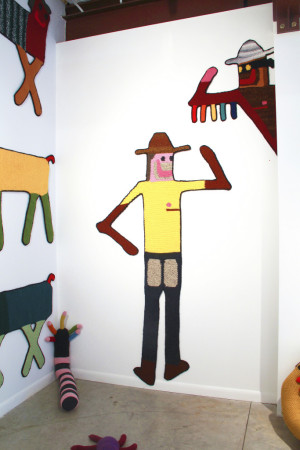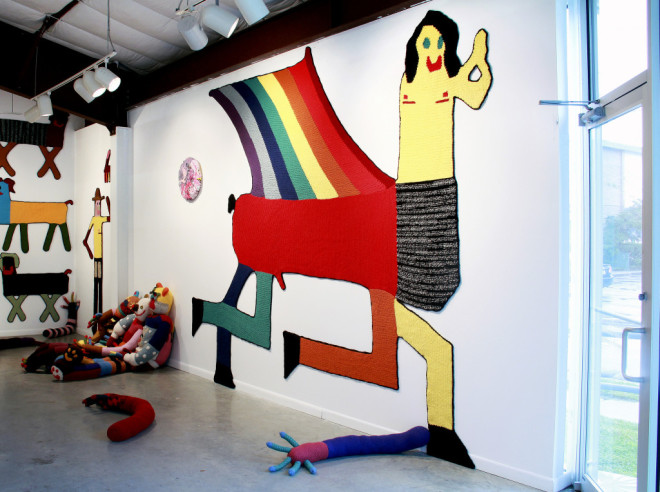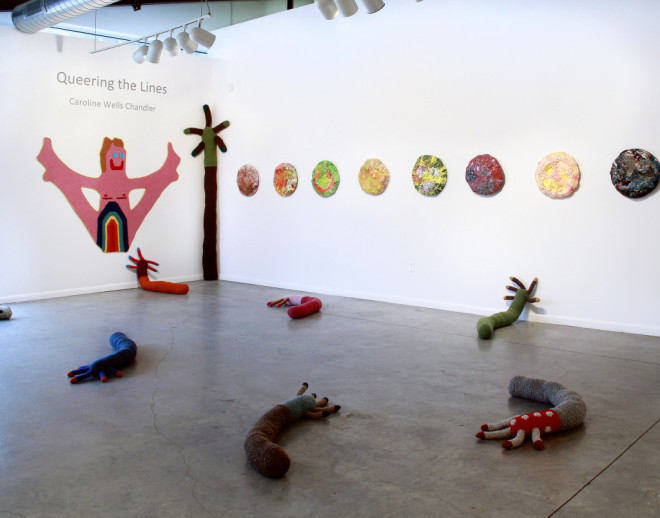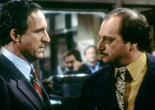Queering the Lines: An Interview with Caroline Wells Chandler

Artist Caroline Wells Chandler (l) with pieces from his ‘Queering the Lines’ exhibit on display at Art League Houston now through April 11. Photo: Andres Alcoser.
By Iva Kinnaird
This will be a very gay show. This is how New York-based transgender artist Caroline Wells Chandler first described Queering the Lines, which is currently on view at Art League Houston (ALH). And the show does not disappoint. The exhibition features paintings of celestial bodies in ceramic drag, as well as hand crocheted drawings and sculptures of bears, antennas, equine familiars, and the axis mundi to explore notions of queerness in all its rainbow spectrum glory!
It’s a happy space, and it’s fun to see (and roll around on the ground with) the pillowy forms that are scattered across the floor of ALH’s Front Gallery. Chandler’s crocheted works sit like child-like drawings on the galleries’ walls. They smile and they wave, playfully exploring themes of desire and identity.
I was lucky enough to chat with Caroline during his stay in Houston, and was able to ask him a bit more about the exhibit and his practice.
I noticed some similarities to Mike Kelley in your work with the toy-like life sized crocheted bears. Looking at your website, I assume you are a fan. How has he influenced you and the way you work?
I’m less interested in establishing lineage with Mike Kelley as an artist and more interested in my work coming out of a feminist craft trajectory for several reasons. Kelley got a lot of flack for colonizing female spaces without real risk because he maintained an authoritative male anthropological position. I see this detached position as a safe place, devoid of real risk, because the personal ceases to be political. It is also important to note that he works with secondary source material in that he gathers and sorts. Furthermore he doesn’t alchemically alter the status of the materials that he works with. In his work, hierarchies are fixed. This perception is treated as a ‘truth’ that I find problematic. Kelley did open things up materially for artists in terms of allowing for low toy culture to be used as material, however most of his work with crochet would not have been possible without the hard work of the feminist art movement. Overwhelmingly, this historical fact seems to be smudged-out in his work.
One idea that I glean from Kelley’s work that is important to me is how an individual maintains autonomy within the face of culture. Differing from Kelley’s singular voice critique position, I’m most interested in critical engagement. Critical engagement allows for the simultaneity of multiple subjectivities coexisting in the same place at the same time in effort to explore constructs. With critical engagement, hierarchies are flattened. Nobody wins and their isn’t a right or wrong or good or evil.
The moon wall pieces came after a series of similarly formed cookie pieces. They seem (to some) to be delicious. I think they look toxic and more radioactive than edible. Your thoughts on that duality?
I really love the haloed icon in altarpiece painting. Hands down Matthias Grunewald’s Isenheim Altarpiece is perhaps the greatest work of art in the world. I love the Tilda Swinton look alike resurrected Jesus. It is so perfectly psychedelic and suggests wonderful ideas regarding boundary dissolution. Especially, I love the torture scene of St. Anthony. I would bet a large sum of money that the beasts in Where the Wild Things Are are based off of the fantastical demons. Interestingly, the hospital that the piece was made for was primarily used to treat ergotism. Ergotism results from ingesting rye infected with fungus. Vivid hallucinations ensue. A strain from that fungus was later the source for the hallucinogen LSD. There is something synchronistic about all that, that resonates with me regarding how I think about making things.
Another altarpiece that I enjoy is Jan Van Eyck’s Ghent Altarpiece. Specifically I really like the faces of the angels that are singing in the choir. There is a synesthetic quality about them in that their contorted faces seem to suggest different tones or sound. I like to think of the moons as the divine gaylien ancestors to that choir of angels.
I’m really interested in the politics of comfort, and how something that is comfortable to one might be oppressive to another. More obviously, in the show some people saw the bears as fun and others creepy which is a delight since the teddy bear is the voodoo doll of the cult of domesticity. Most Americans eat lots of food that looks psychedelic or on par with the coloring of toxic insects. The pieces are not intended to be a critique of food, but more so an exploration of color.
Most of my friends say that my work is incredibly warm, generous, and scary which I think are all accurate adjectives to describe me. Those words are what I think about when I think of the sublime. For me the Neo-Sublime integrates the figure within the environment creating a permanent state of boundary dissolution and formlessness. It also simulates the process of integrating the subconscious with the conscious mind. I see this best expressed in the moons.
We all love the cowboys (Howdy and Lone Ranger) in the show. You mentioned spending time in Texas as a child. How did you decide what type of characters to create and include in this show?
When I am given an opportunity to do a show on my terms, I really enjoy responding to the architecture of the space to create an environment. This show was a gift for a number of reasons, but especially because I was not rushed and I was allowed to plan it over a year. I stared at a plan for the space and made several sketches of possibilities in a spiral notebook. I began to really panic in October to get my act together and start actually making the work which is incredibly labor intensive because all of it is hand crocheted.
I like esoteric lore, alchemy, mythology, and shamanism coupled with my own experience. I completed my undergraduate studies at Southern Methodist University in Dallas, and lived in Tyler, which is where my mother’s family is from, for two years after graduating from SMU. One thing that I heard repeatedly while I lived in Texas was that if they legalize gay marriage then people will marry their horse. That was always really interesting to me, because it was such an absurdly creative conclusion. To me it seemed perfect to cannibalize that idea and make a room of steers and queers. I knew that I wanted a wall depicting the result of unbridled desire with the children of a forbidden love. Centaurs of course are the perfect form for this. The first centaur I made was about a year ago. It is titled Wonder Boi. For Wonder Boi I was thinking about Trojan horses and how they relate to passing and how passing in some situations allows one to know how they might stand if they are considered an insider when in reality they might actually be an outsider.
Howdy was made back in August. I wanted to have him in the show but I thought that cowboys were too obvious so I put him aside until the other images came together. The cowboys are essentially leather daddy bears of a different order. I think Texas is a breeding ground for politically empowered queer people. The emphasis on rugged individualism coupled with an everything is bigger in Texas attitude has potentially explosive implications.
I wasn’t sure until February that the moons would be in the show. After I made Icaro, I was certain. Icaro, named itself. I looked it up and was delighted to see pictures of Icarus which is very different in tone for what I was going for but still interesting and important. The ending of Icaro is ‘o’ which is Carl Jung’s structure for the self in the process of individualization. The ending of Icarus is ‘us’ which for me is the opposite of ‘o’ because the self becomes integrated and at a great cost if one is to think of the mythological story of Icarus. An icaro is a song learned from a plant spirit that is sung by the Shipibo Indians in ayahuasca ceremonies. By controlling the tone and the pitch of their voice, the shaman’s song creates a synesthetic visionary experience of color for the participant in the ayahuasca ceremony. The etymology of icaro is the Quechua work ikaray which means to blow smoke in order to heal. Icaro looks as if they are playing a flute. I like to think of the moon paintings as songs of color. This resonates with me further because my name is Caroline which means to sing joyfully.
The arm/wand/antenna forms on the floor look like chakapas which are used by the Shipibo shamans during ayahuasca ceremonies to clear out bad vibes and direct energy. I also like to think of them as a chopped up regenerating form. When fisherman tried to kill starfish they mistakenly thought the best method was to chop them up into tiny bits. The starfish regenerated fivefold. The largest antenna in the room is the Axis Mundi which is also known as the world tree. It is thought that the axis mundi is a connector or bridge for shamans to travel to lower and higher realms in effort to bring back knowledge. Commonly the alchemical figure of the hermaphrodite is seen in relation to the axis mundi as a symbol of unity and immortality. This of course is why Orgin resides at the base.
Orgin references Gustave Courbet’s Origin of the World. I wanted to make a celebratory and fierce genderqueer archetypal figure. An influence for Orgin’s conception are the guardian figures in Tantric Himalayan Buddhist art. They are sometimes mislabeled as ferocious but fierce is more accurate because they are jolly and humorous and serve as protector deities. Orgin depicts a figure with top surgery and what I hope reads as a pulsating and moving rainbow for genitals. The rainbow genital choice is in response to what I view as a strange obsession of the public regarding the genitals of trans and queer bodies.
Despite conservative politics in Texas, a lot has changed in the past ten years in terms of sentiments regarding LGBTQ people. I remember watching Brokeback Mountain in the theaters in Dallas and people actually booed. I did not have one out queer teacher or adult in my life until graduate school. Deb Kass was the first teacher who openly talked about being a lesbian. Part of me really wished that I was a lesbian too, because all of the best living painters are lesbians. I was also fortunate to take Dean Daderko’s Queer Strategies seminar which changed my life, because it provided me words that were not a part of my preexisting vocabulary to express how I felt grounded in my body.
How much of your work is portraiture or self-portraits? And what makes a work a portrait vs a created character?
A good portrait traps the essence of a person and is best when it reveals something unexpected about who that person is which may not be immediately obvious. A created character does not have to play by those same rules and I would argue that perhaps a character has a narrative or literary function. I’m less interested in narrative and more interested in the works having a literary function primarily in terms of visual literacy. This is referenced in the bodies of the figures in that they simulate text. Text of course is the building blocks of language and language creates the realities we navigate, and how we do so in our bodies.
I make things that I need to see. I make things that reflect my interests. I tend to make things that make me feel good or laugh because they are bombastic, dementedly funny, and empowering. A lot of the smiles remind me of the awkward faces that little kids make when they are getting their picture taken. I like to joke around with my partner and make those kinds of faces. Some of the pieces are inspired by my friends. At times some of the work looks like me, but more often most of the work feels like me.
The work (specifically with Orgin and the Dreamer Bear) presents images which are playful and have a child-like innocence to them while also being aware of their own sexuality. How do you view the works in relation to this innocence and awareness of sexualized identity?
I’m not really sure of the sexuality or sexualized identity of Orgin or Dreamer. Based on the installation it looks like Orgin is about to be plowed by Icaro and planets seem to be shooting out of their pulsating rainbow cave. Further adding confusion as to where planets come from, a gaseous planet seems to be farted out of Icaro‘s butt-hole. Dreamer has a girthy penis that begins to read as a grafted strap-on because of the lack of balls and a meticulously constructed penetrable vagina. They all have a self possessed confidence in their bodies.
Prior to when culture sinks its teeth in, children tend to have a very open relationship to their bodies until they learn shame. I’m very interested in that precultural state prior to propaganda because I find it to be liberating and affirmational.
In what ways does your own identity (specifically as someone who identifies as queer) manifest in the works?
If anyone has made it to the end of this interview, I believe that they would agree that your question has been answered thoroughly.
Caroline Wells Chandler’s Queering the Lines will be on view at Art League Houston through April 11th.
Born in Norfolk, Virginia, Caroline Wells Chandler currently lives and works in New York. He completed his foundation studies at the Rhode Island School of Design and received his BFA cum laude from Southern Methodist University in 2024. He has shown at numerous institutions including: Zurcher Studio (NY), Anna Kustera (NY), Field Projects (NY), Vox Populi (PA), Sanctuary (PA), N’Namdi Center for Contemporary Art (MI), Open Gallery (TN), The Bascom (NC), Arlington Arts Center (VA), and the Stieglitz Museum (‘s-Hertogenbosch, The Netherlands) among others. Chandler is a 2024 MFA recipient in painting at the Yale School of Art where he was awarded the Ralph Mayer Prize for proficiency in materials and techniques. He lives and works in New York. Queering the Lines will mark the third solo show within a year for the artist.
This interview was first published in OutSmart Magazine, which can be found here.
by Guest Author




















